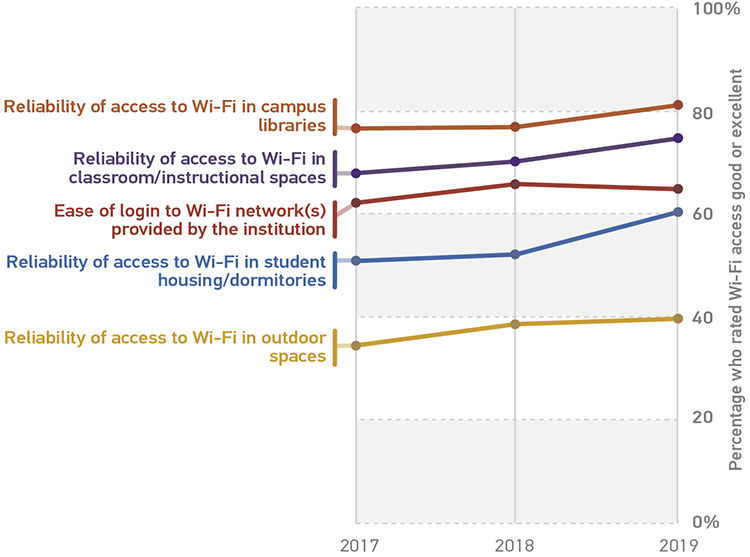Technology Experiences
Students are generally happy, but Wi-Fi access could (of course!) be better.
Technology is woven into practically every aspect of the student experience. Whether students are enrolling in a course, submitting a paper, downloading an article from the library, FaceTiming with family, or streaming The Office between classes, they rely heavily on the digital resources provided by their institutions for their work, personal business, and leisure. Students are the largest group of end users IT units serve; as a result, their satisfaction with the technologies their institutions supply and support matters. And from what students tell us, their schools are doing a solid job of providing positive, comprehensive technology experiences. As in the past two years, more than three-quarters (79%) of respondents reported their overall technology experiences as good or excellent, and this was consistent across institution size and type, as well as key demographic factors such as gender, ethnicity, and age. Only 2% of students reported their experiences with technology as poor.
Other trends that also seem to be holding are those related to student experiences with access to campus Wi-Fi. While the majority of respondents (65%) rated their Wi-Fi login experience as favorable, our data suggest that some campus access points (APs) are still better than others. Our previous research has shown that student experience with technology as a whole is associated with the quality of their interactions with their campus networks.1 Libraries continue to be the most reliable spot on campus to connect to Wi-Fi, with the majority of respondents (81%) rating access as good or excellent, and classrooms/instructional spaces are a close second (74%). Sixty percent of respondents rated wireless access in student housing and dorms as positive, which is a slight increase from 2018 (52%). But with nearly a quarter (24%) of students reporting access as poor or fair in on-campus residences, room for improvement remains. And our results suggest that there's even more work to be done when it comes to Wi-Fi in outdoor spaces. These spaces on campus received the lowest marks for reliable access, with 38% of students reporting their experiences as poor or fair.
Although gains have been seen in positive experiences with Wi-Fi in campus housing and outdoor spaces since 2017, the needle is moving slowly (figure 4), and higher education IT should continue its efforts to improve the reliability of access in these areas. To decrease wireless network pain points in residence halls, IT units can look for solutions that cut down on connectivity confusion. For example, Elon University switched entirely to wireless in residence halls and then configured dual networks to funnel traffic on the basis of device type—one for academic workhorse tech such as laptops and another "gadget network" for gaming and other smart devices.2 Upgrading wireless access in dormitory rooms can greatly reduce (or eliminate entirely) the number of students who supply their own access points, which may interfere with each other and impact access.3 To increase outdoor connectivity, Kennesaw State University and other institutions have doubled the number of APs, using those with directional antennas to boost coverage. Selecting APs that are durable and waterproofing them for wet climates can also bolster their functionality, adding to their longevity.4 Improving Wi-Fi reliability in outdoor campus spaces can be particularly helpful for students on tight budgets, as it allows them to offset the costs of their own data plans by using secure public networks.

Notes
-
D. Christopher Brooks, ECAR Study of Undergraduate Students and Information Technology, 2016, research report (Louisville, CO: ECAR, October 2016), 17–18.
↩︎ -
Chris Hayhurst, "Colleges Optimize Traffic on Busy Residence Hall Networks," EdTech, October 12, 2018.
↩︎ -
Ibid.
↩︎ -
Dan Tynan, "Colleges Tackle the Great Outdoors in Campus Wi-Fi Upgrades," EdTech, October 11, 2018.
↩︎